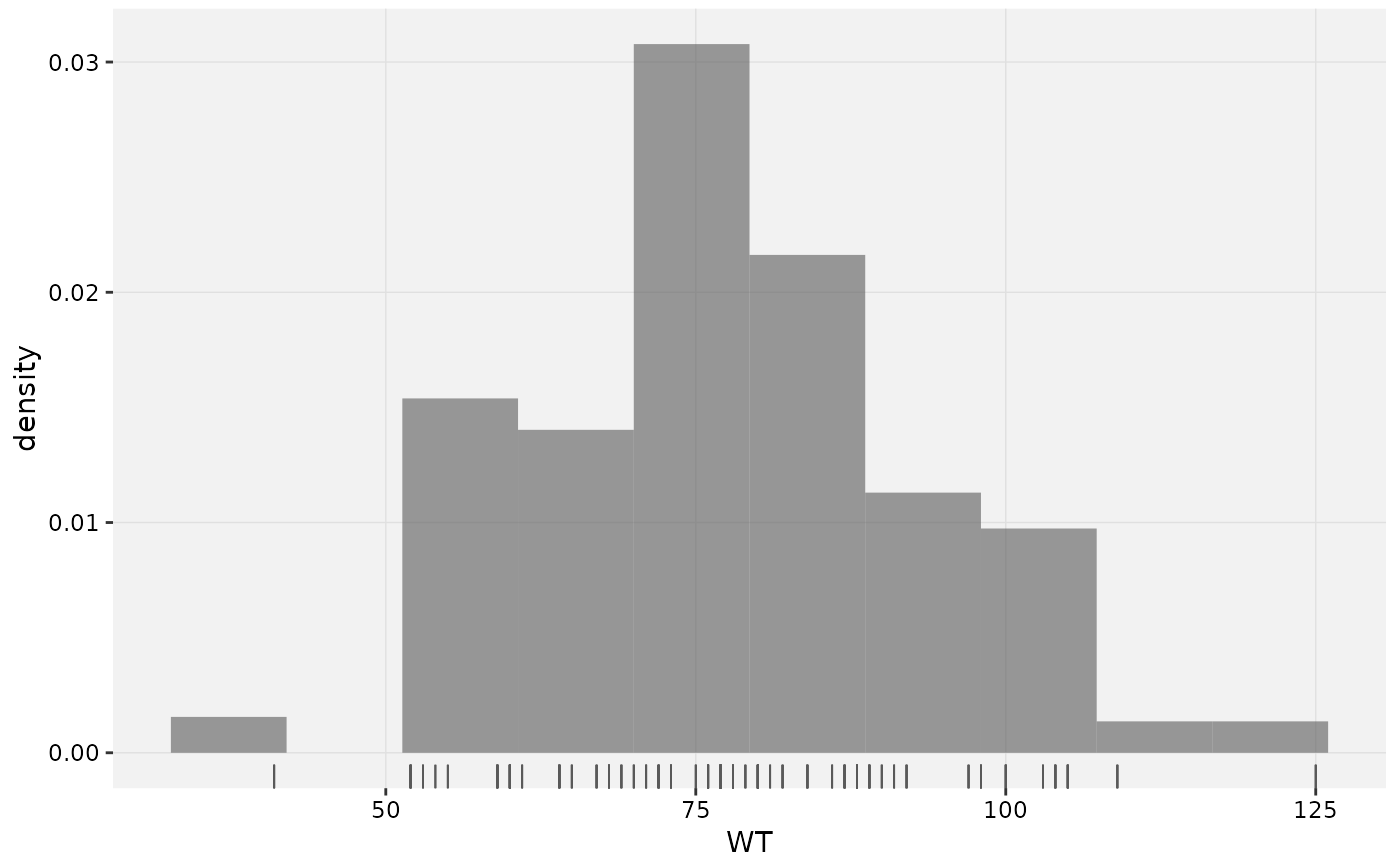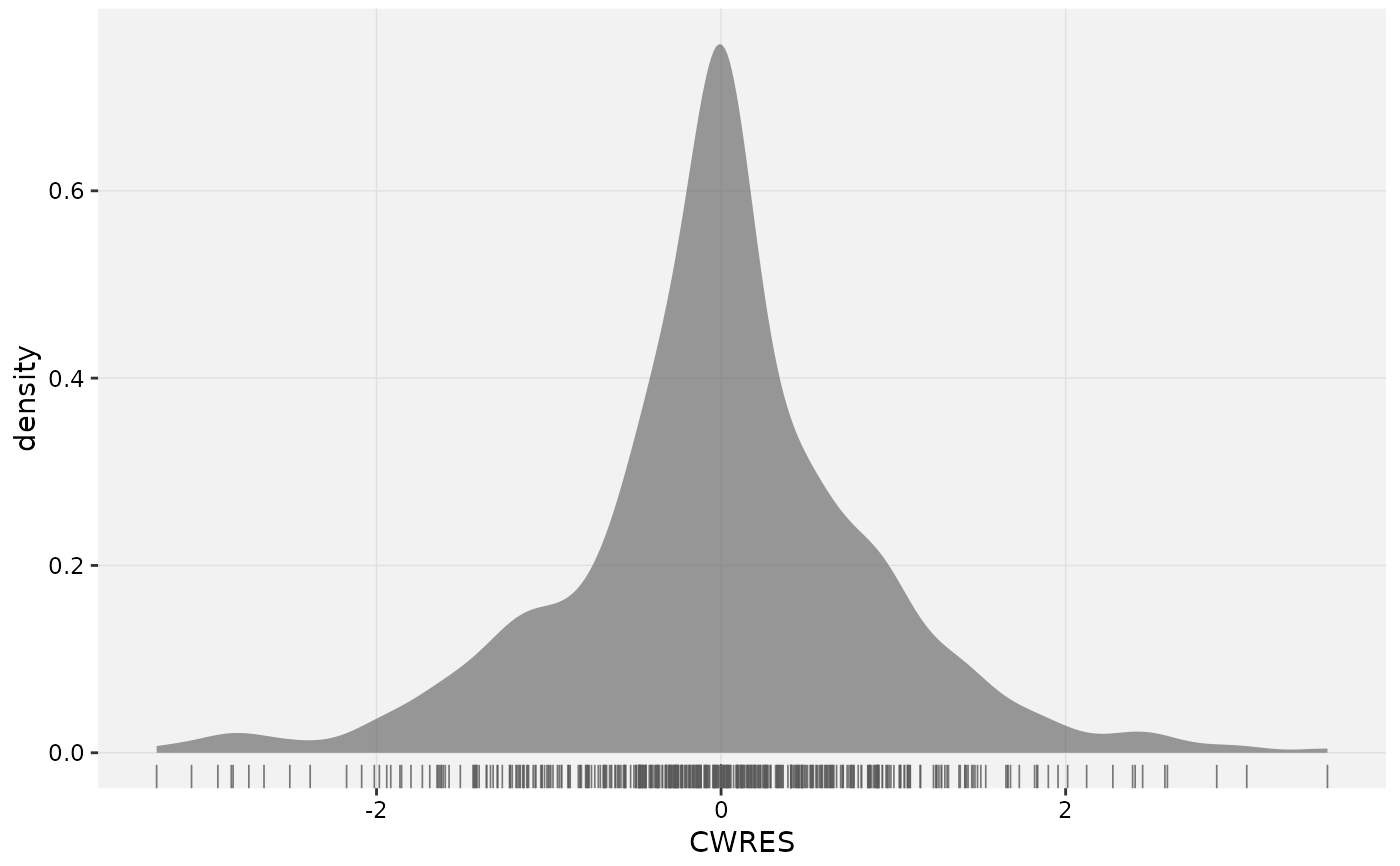Manually generate distribution plots from an xpdb object.
xplot_distrib(
xpdb,
mapping = NULL,
type = "hr",
guide = FALSE,
xscale = "continuous",
yscale = "continuous",
title = NULL,
subtitle = NULL,
caption = NULL,
tag = NULL,
plot_name = "density_plot",
gg_theme,
xp_theme,
opt,
quiet,
...
)Arguments
- xpdb
An
xpose_dataobject generated withxpose_data.- mapping
List of aesthetics mappings to be used for the xpose plot (e.g.
point_color).- type
String setting the type of plot to be used. Can be histogram 'h', density 'd', rug 'r' or any combination of the three.
- guide
Should the guide (e.g. reference distribution) be displayed.
- xscale
Scale type for x axis (e.g. 'continuous', 'discrete', 'log10').
- yscale
Scale type for y axis (e.g. 'continuous', 'discrete', 'log10').
- title
Plot title. Use
NULLto remove.- subtitle
Plot subtitle. Use
NULLto remove.- caption
Page caption. Use
NULLto remove.- tag
Plot identification tag. Use
NULLto remove.- plot_name
Name to be used by
xpose_save()when saving the plot.- gg_theme
A complete ggplot2 theme object (e.g.
theme_classic), a function returning a complete ggplot2 theme, or a change to the currentgg_theme.- xp_theme
A complete xpose theme object (e.g.
theme_xp_default) or a list of modifications to the currentxp_theme(e.g.list(point_color = 'red', line_linetype = 'dashed')).- opt
A list of options in order to create appropriate data input for ggplot2. For more information see
data_opt.- quiet
Logical, if
FALSEmessages are printed to the console.- ...
Any additional aesthetics.
Layers mapping
Plots can be customized by mapping arguments to specific layers. The naming convention is layer_option where layer is one of the names defined in the list below and option is any option supported by this layer e.g. histogram_fill = 'blue', rug_sides = 'b', etc.
histogram: options to
geom_histogramdensity: options to
geom_densityrug: options to
geom_rugxscale: options to
scale_x_continuousorscale_x_log10yscale: options to
scale_y_continuousorscale_y_log10
Faceting
Every xpose plot function has built-in faceting functionalities. Faceting arguments
are passed to the functions facet_wrap_paginate when the facets
argument is a character string (e.g. facets = c('SEX', 'MED1')) or
facet_grid_paginate when facets is a formula (e.g. facets = SEX~MED1).
All xpose plot functions accept all the arguments for the facet_wrap_paginate
and facet_grid_paginate functions e.g. dv_vs_ipred(xpdb_ex_pk,
facets = SEX~MED1, ncol = 3, nrow = 3, page = 1, margins = TRUE, labeller = 'label_both').
Faceting options can either be defined in plot functions (e.g. dv_vs_ipred(xpdb_ex_pk,
facets = 'SEX')) or assigned globally to an xpdb object via the xp_theme (e.g. xpdb
<- update_themes(xpdb_ex_pk, xp_theme = list(facets = 'SEX'))). In the latter example all plots
generate from this xpdb will automatically be stratified by `SEX`.
By default, some plot functions use a custom stratifying variable named `variable`, e.g.
eta_distrib(). When using the facets argument, `variable` needs to be added manually
e.g. facets = c('SEX', 'variable') or facets = c('SEX', 'variable'), but is optional,
when using the facets argument in xp_theme variable is automatically added whenever needed.
Template titles
Template titles can be used to create highly informative diagnostics plots.
They can be applied to any plot title, subtitle, caption and tag. Template titles
are defined via a single string containing key variables staring with a `@` (e.g. `@ofv`)
which will be replaced by their actual value when rendering the plot.
For example `'@run, @nobs observations in @nind subjects'` would become
`'run001, 1022 observations in 74 subjects'`. The available key variables
are listed under template_titles.

